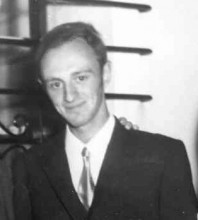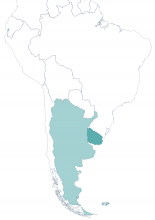Daniel Álvaro Banfi Baranzano was born in Montevideo (Uruguay) on 28th October 1950.
He was training to become a priest at the Old Seminary of St. Michael the Archangel (Buenos Aires, Argentina) in 1967. Aged eighteen, Daniel was arrested at the Montevideo police headquarters for handing out flyers at a student demonstration against the exceptional measures implemented by the government of the then president, Jorge Pacheco Areco.
At that moment, Daniel was linked to the Movimiento 26 de Marzo (26th-March Movement, 26M) and had abandoned his religious training to get married. In 1972, once repression and political persecution were on the rise, Daniel settled in Argentina with his wife, Aurora Meloni, and their two daughters.
During the early morning of 13th September 1974, a group of heavily armed Uruguayan and Argentine agents dressed as civilians broke into Daniel's family home in the town of Haedo situated in the Morón district, Buenos Aires Province. Upon entering the house, the agents found Daniel accompanied by his wife and children, parents-in-law, and two Uruguayan friends, Luis Enrique Latrónica Damonte and Rivera Moreno.
The head of the operation was the Uruguayan superintendent, Hugo Campos Hermida. The three young men were arrested. Aurora was told that they would be taken to the Superintendencia de Coordinación Federal (Superintendence of Federal Coordination) on Moreno Street in Buenos Aires. The building housed one of the superintendencies of the Argentine Federal Police, the Seguridad Federal (Federal Security), whose operations included political repression.
Campos Hermida asked the men about their relation to Alberto Correa: a member of the National Liberation Movement (Movimiento de Liberación Nacional -Tupamaros, MLN-T) who the agents had arrested a fortnight before. Daniel had met Correa when they were both training to become priests. The officers had found his surname, Banfi, in one of Correa's diaries.
These arrests were part of a wider framework of operations against Uruguayan exiles carried out during those days. On the night of 12th to 13th September, it is likely that the same group of armed men abducted the Uruguayan Nicasio Romero, who worked in the company where Daniel was employed. On 13th September, at midday, they abducted Guillermo Jabif from his sister's home. Of the five young men, only Romero and Rivera Moreno survived, having endured one month of torture before their release on 14th October. Their testimonies revealed that during their detention, they realised that the guards were Argentine and the torturers were Uruguayan based on their voices.
For weeks, Daniel's wife, Aurora Meloni, together with Guillermo Jabif's mother, Olga, tirelessly searched for the five abducted men at various police stations and resorted to meetings with different Argentine authorities to no avail including the Casa Rosada (the Argentine presidential office and seat of national government).
On 29th October 1974, the bodies of Daniel Banfi, Guillermo Jabif, and Luis Latrónica appeared half-buried in a field in the city of San Antonio de Areco, Buenos Aires Province. They were covered in various gunshot wounds and quicklime, marking the violence that the victims had suffered. Almost 50 days had passed since their abduction.
The press and authorities quickly attributed the assassinations to a renowned far-right group called the Argentine Anticommunist Alliance (Alianza Anticomunista Argentina, AAA). However, this case, alongside other abductions and executions carried out the same year, revealed the active collaboration of Uruguayan and Argentine forces in the repressive coordination later formalised under Operation Condor.
Daniel's homicide was investigated by the Italian Condor trial, which sentenced the former Foreign Minister of the Uruguayan dictatorship, Juan Carlos Blanco, to a final judgment in July 2021.


